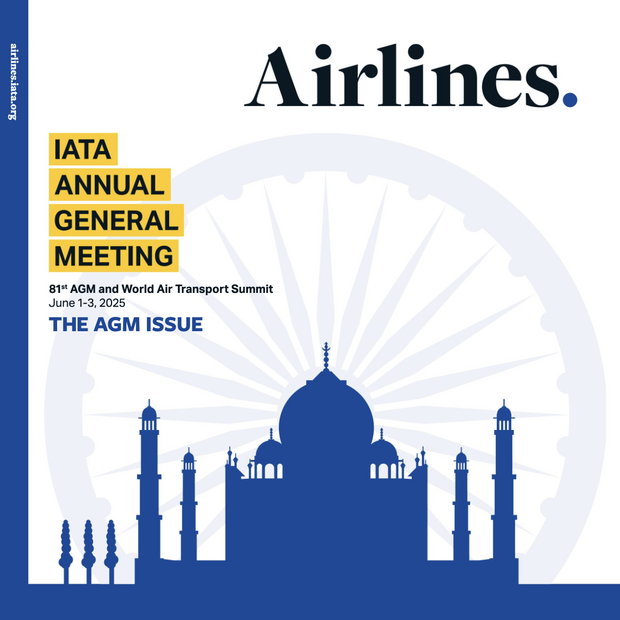
Translations: 国际航协:2023年全球航空旅行需求全年保持复苏态势 (pdf)
La demanda global del transporte aéreo de pasajeros continuó recuperándose en 2023 (pdf)
Recuperação da demanda global por viagens aéreas continuou em 2023 (pdf)
الطلب العالمي على السفر الجوي يواصل انتعاشه في عام 2023 (pdf)
Geneva - The International Air Transport Association (IATA) announced that the recovery in air travel continued in December 2023 and total 2023 traffic edged even closer to matching pre-pandemic demand.
Total traffic in 2023 (measured in revenue passenger kilometers or RPKs) rose 36.9% compared to 2022. Globally, full year 2023 traffic was at 94.1% of pre-pandemic (2019) levels. December 2023 total traffic rose 25.3% compared to December 2022 and reached 97.5% of the December 2019 level. Fourth quarter traffic was at 98.2% of 2019, reflecting the strong recovery towards the end of the year.
International traffic in 2023 climbed 41.6% versus 2022 and reached 88.6% of 2019 levels. December 2023 international traffic climbed 24.2% over December 2022, reaching 94.7% of the level in December 2019. Fourth quarter traffic was at 94.5% of 2019.
Domestic traffic for 2023 rose 30.4% compared to the prior year. 2023 domestic traffic was 3.9% above the full year 2019 level. December 2023 domestic traffic was up 27.0% over the year earlier period and was at 2.3% above December 2019 traffic. Fourth quarter traffic was 4.4% higher than the same quarter in 2019.
“The strong post-pandemic rebound continued in 2023. December traffic stood just 2.5% below 2019 levels, with a strong performance in quarter 4, teeing-up airlines for a return to normal growth patterns in 2024. The recovery in travel is good news. The restoration of connectivity is powering the global economy as people travel to do business, further their educations, take hard-earned vacations and much more. But to maximize the benefits of air travel in the post-pandemic world, governments need to take a strategic approach. That means providing cost-efficient infrastructure to meet demand, incentivizing Sustainable Aviation Fuel (SAF) production to meet our net zero carbon emission goal by 2050, and adopting regulations that deliver a clear cost-benefit. Completing the recovery must not be an excuse for governments to forget the critical role of aviation to increasing the prosperity and well-being of people and businesses the world over,” said Willie Walsh, IATA’s Director General.
Air Passenger Market in Detail
| December 2023 (% year-on-year) | World Share1 | RPK | ASK | PLF(%-PT)2 | PLF(Level)3 |
|---|---|---|---|---|---|
| Total Market | 100% | 25.3% | 24.1% | 0.8% | 82.1% |
| Africa | 2.1% | 12.1% | 18.7% | -4.3% | 73.2% |
| Asia Pacific | 22.1% | 60.7% | 53.4% | 3.7% | 81.2% |
| Europe | 30.8% | 12.5% | 12.3% | 0.1% | 85.1% |
| Latin America | 6.4% | 16.3% | 10.4% | 4.2% | 82.7% |
| Middle East | 9.8% | 16.4% | 17.2% | -0.6% | 78.2% |
| North America | 28.8% | 10.6% | 12.0% | -1.0% | 82.9% |
1) % of industry RPKs in 2022 2) Year-on-year change in load factor 3) Load Factor Level
International Passenger Markets
Asia-Pacific airlines posted a 126.1% rise in full year international 2023 traffic compared to 2022, maintaining the strongest year-over-year rate among the regions. Capacity rose 101.8% and the load factor climbed 9.0 percentage points to 83.1%. December 2023 traffic rose 56.9% compared to December 2022.
European carriers’ full year traffic climbed 22.0% versus 2022. Capacity increased 17.5%, and load factor rose 3.1 percentage points to 83.8%. For December, demand climbed 13.6% compared to the same month in 2022. December traffic was higher than the corresponding month in 2019 for the first time since the start of the pandemic.
Middle Eastern airlines saw a 33.3% traffic rise in 2023 compared to 2022. Capacity increased 26.0% and load factor climbed 4.4 percentage points to 80.1%. December demand climbed 16.6% compared to the same month in 2022.
North American carriers reported a 28.3% annual traffic rise in 2023 compared to 2022. Capacity increased 22.4%, and load factor climbed 3.9 percentage points to 84.6%. December 2023 traffic rose 13.5% compared to the year-ago period.
Latin American airlines posted a 28.6% traffic rise in 2023 over full year 2022. Annual capacity climbed 25.4% and load factor increased 2.1 percentage points to 84.7%, the highest among the regions. December demand climbed 26.5% compared to December 2022.
African airlines’ annual traffic rose 38.7% in 2023 versus the prior year. Full year 2023 capacity was up 38.3% and load factor climbed 0.2 percentage points to 71.9%, the lowest among regions. December 2023 traffic for African airlines rose 9.5% over December 2022.
Domestic Passenger Markets
| December 2023 (% year-on-year) | World Share1 | RPK | ASK | PLF(%-PT)2 | PLF(LEVEL)3 |
|---|---|---|---|---|---|
| Domestic | 41.9% | 27.0% | 22.9% | 2.7% | 82.3% |
| Domestic Australia | 1.0% | 6.6% | 4.1% | 1.9% | 82.1% |
| Domestic Brazil | 1.5% | 5.9% | 0.7% | 4.0% | 81.4% |
| Domestic China P.R. | 6.4% | 147.1% | 105.0% | 13.4% | 78.4% |
| Domestic India | 2.0% | 8.2% | 6.1% | 1.8% | 90.6% |
| Domestic Japan | 1.2% | 0.9% | -2.4% | 2.4% | 73.8% |
| Domestic US | 19.2% | 9.6% | 10.2% | -0.5% | 83.4% |
1) % of industry RPKs in 2022 2) year-on-year change in load factor 3) Load Factor Level
China’s full year domestic traffic rose 138.8% versus 2022, and is now 7.1% above the 2019 level.
Australia (-4.2% compared to 2019) and Japan (-3.2% compared to 2019) are the only major domestic markets yet to recover pre-pandemic traffic demand.
Air Passenger Market Overview - December 2023
| December 2023 (% CH vs same month in 2019) | World Share1 | RPK | ASK | PLF (%-PT)2 | PLF (LEVEL)3 |
|---|---|---|---|---|---|
| Total Market | 100.0% | -5.9% | -5.6% | -0.3% | 82.3% |
| International | 58.1% | -11.4% | -12.3% | 0.8% | 82.8% |
| Domestic | 41.9% | 3.9% | 6.5% | -2.1% | 81.5% |
1) % of industry RPKs in 2022 2) year-on-year change in load factor 3) Load Factor Level
The Bottom Line
“Our push to connect our world even more strongly than before the pandemic must not come at the expense of our environment. The industry’s goal to reach net zero CO2 emissions by 2050 remains steadfast. To accelerate the transition, we need governments and fuel suppliers to step up and do more. We saw a strong increase in the use of SAF in 2023, but SAF is still only 3% of all global renewable fuels production. That is unacceptable. Aircraft have no option but to rely on liquid fuels, whereas other transport modes have alternatives. A massive collective effort is needed to increase SAF output as a proportion of overall renewable fuel production as quickly as possible,” said Walsh.
> View the December Air Passenger Market Analysis (pdf)
For more information, please contact:
Corporate Communications
Tel: +41 22 770 2967
Email: corpcomms@iata.org
Notes for Editors:
- IATA (International Air Transport Association) represents some 350 airlines comprising over 80% of global air traffic.
- You can follow us on X for announcements, policy positions, and other useful industry information.
- Fly Net Zero
- Statistics compiled by IATA Economics using direct airline reporting complemented by estimates, including the use of FlightRadar24 data provided under license.
- All figures are provisional and represent total reporting at time of publication plus estimates for missing data. Historic figures are subject to revision.
- Domestic RPKs accounted for about 41.9% of the total market in 2022. The six domestic markets in this report account for 31.3% of global RPKs.
- Explanation of measurement terms:
- RPK: Revenue Passenger Kilometers measures actual passenger traffic
- ASK: Available Seat Kilometers measures available passenger capacity
- PLF: Passenger Load Factor is % of ASKs used.
- IATA statistics cover international and domestic scheduled air traffic for IATA member and non-member airlines.
- Total passenger traffic market shares by region of carriers for 2022 in terms of RPK are: Asia-Pacific 22.1%, Europe 30.8%, North America 28.8%, Middle East 9.8%, Latin America 6.4%, and Africa 2.1%.

